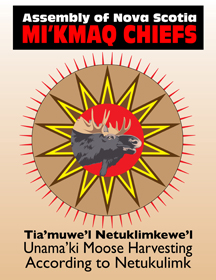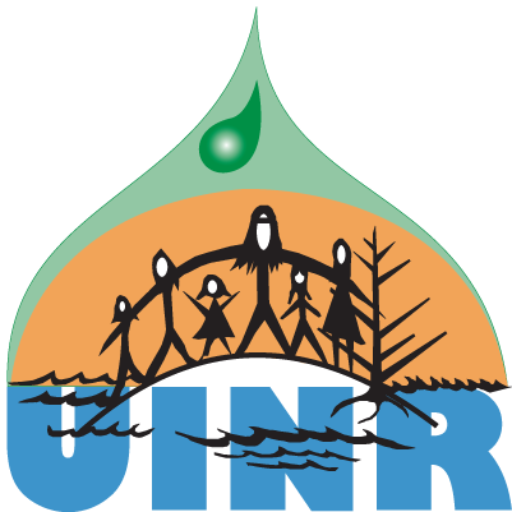The Cape Breton Highlands have always been known as traditional Mi’kmaq hunting grounds. In fact, a Mi’kmaq hunter recently found a 4500 year-old arrowhead there, evidence that Mi’kmaq hunted there for thousands of years.
However, in the 1800s, moose disappeared from Unama’ki and this ancient relationship came to an abrupt end that lasted for almost 100 years. Cape Breton Mi’kmaq were separated from a very valuable resource and all it offered.
 In the 1940s, Parks Canada brought 18 moose to the Cape Breton Highlands to give tourists a large mammal to see in the Park. The moose liked it here. Lots to eat, room to roam and they flourished and spread. In the absence of their major predators, wolves, Unama’ki became a moose haven, especially after the spruce budworm devastation of the 1970s. With a massive clearcutting of damaged softwood, hardwood shoots began to grow, offering ideal browse conditions for moose to thrive.
In the 1940s, Parks Canada brought 18 moose to the Cape Breton Highlands to give tourists a large mammal to see in the Park. The moose liked it here. Lots to eat, room to roam and they flourished and spread. In the absence of their major predators, wolves, Unama’ki became a moose haven, especially after the spruce budworm devastation of the 1970s. With a massive clearcutting of damaged softwood, hardwood shoots began to grow, offering ideal browse conditions for moose to thrive.
The 1970s and 80s were a also a time of heavy litigation in the courts, with Mi’kmaq hunters being charged and treaties tested. Late in the 1980s, the Mi’kmaq proved that our treaties were valid, proving to Canada and the rest of the world that Mi’kmaq treaties still existed and were in
force. These litigation victories coincided and grew with the moose population–10,000 animals from the original 18. A real population explosion!
With the traditional relationship between Mi’kmaq and moose reestablished, the Mi’kmaq felt it was time to become managers and stewards of
the resource, to manage the hunt for our children and their children–the next seven generations. Mi’kmaq Elders advised that with these rights come great responsibilities. They saw the importance of balance, conservation and preservation of the herd and said the time had come for self-management.
In response to Elders and community members concerns, Grand Council asked Charlie Dennis to take on moose management as part of his duties. With Parks Canada, he established two committees and began to develop draft guidelines. This process reached a stumbling block–Mi’kmaq could not govern our people while off reserve where the hunting takes place.
It was clear that we were dealing with Mi’kmaq rights and, in the early 2000s, the issue was brought to the Assembly of Nova Scotia Mi’kmaq Chiefs. As a result, Kwilmu’kw Maw-klusuaqn (KMK) established the Moose Working Group and moose management became an important first issue to establish Mi’kmaq rights and unify the concerns of the Nova Scotia Mi’kmaq communities.
In 2006, Clifford Paul was hired as Moose Management Coordinator. His role at UINR is to engage Nova Scotia Mi’kmaq communities in active discussions around moose issues and promote discussions on the management of the Cape Breton moose herd and hunting practices. Clifford’s philosophy is simple. We come to your community with a blank book. You tell us what is right and what you feel is important and we will listen.
Over the next couple of years, Clifford and a team of advisors from KMK visited every Mi’kmaq community in Nova Scotia to talk moose. He heard a deep concern for conservation and protection of the herd so it will available for future generations. A more respectful relationship is required and, as stewards of the resource, communities’ communal rights take priority over individual rights.
Clifford visited each community several times, gathering information and seeing common themes arising at every meeting. In September of 2008, Mawikwamk Wjit Tia’muk–Mi’kmaq–Gathering on Moose was held in Wagmatcook, bringing together delegates from across Nova Scotia to look at some of the issues important to moose management. The two-day event reached consensus on three issues:
- Non-native accompaniment
- No-hunting time/A Mi’kmaq hunting season
- Hunter advisory groups
A fourth issue, selling moose, did not achieve consensus and further discussions are needed.
Out of this session, draft guidelines were developed and brought to the Assembly of Nova Scotia Mi’kmaq Chiefs for review. Changes were made and now Tiamuwel Netuklimkewe–Unama’ki Moose Harvesting According to Netukulimk was approved.
The Guidelines will be officially released on August 17 asking Mi’kmaq hunters for voluntary compliance over the next two years. Over this time, Clifford and his team will again visit communities to talk about the Guidelines, answer questions and work out more details for the future.
Clifford explains, The Guidelines are just one tool in the management plan. The Mi’kmaq Legal Support Network is developing the legal regulations and at the same time, we are moving forward with our Natural Resource Officer Program.
The key component in our management plan is the Mi’kmaq response to these initial Guidelines. It is a living document and through the hunters’ and communities’ feedback we will once again regain stewardship over this important resource.
clifford @uinr.ca
Tiamuwel Netuklimkewe–Unama’ki Moose Harvesting According to Netukulimk will be released on August 17 at a press conference in Wagmatcook. Following the official release, it will be available in every Mi’kmaq community and can be downloaded at www.uinr.ca.
The voluntary guidelines focus on 5 main areas:
- Safety
- Community Authority and Hunting Advisory Groups
- The No-Hunting Time
- ID and Non-Mi’kmaq Helpers
- Hunter Reporting
